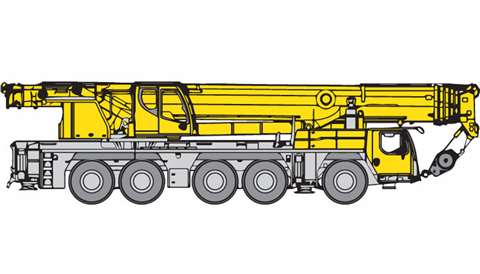All terrain ability
24 November 2015

Thomas Schramm, Tadano general manager sales and marketing, explains the importance of high gradient capability in all terrain cranes to Alex Dahm.
All terrain cranes working all over the world are subjected to the widest range of surfaces, from smooth paved roads to near-swamp conditions and everything in between. A fundament of the all terrain crane concept is presented as the ability to cope both with rough, muddy terrain and also on-highway conditions. The idea is that it is the best of both worlds, combining RT and truck crane performance. Certain characteristics that permit travelling on the road at high speed while providing the ability to conquer rough ground conditions on site need to be combined into one vehicle.
The main obstacle on site, other than often a lack of space, is the ability to move off-road under various ground conditions (apart from off-road conditions, on-road conditions may also be adverse, for example, snow and ice during cold weather.)
To get the vehicle moving there are some important factors:
1. What is the weight to be moved and at which gradient?
2. What power can be transferred to the road due to available friction between the tyres and the ground?
3. What is the available power to be transferred to the tyres?
Weight and power are predefined factors for each crane, even though the weight may be different from the actual road travel condition because weight may be increased as a result of travel on site with a boom attachment and-or, with counterweight on board. On the other hand, the available friction between tyre, ground and gradient is of major importance to the determination of how well the crane can move on rough ground.
Friction
If the weight and power is a given, the question remaining is: Is there enough power to move the crane forward? And is the ground condition or friction condition between tyre and surface providing sufficient friction that the power can be transferred? If sufficient then it is only a question of whether sufficient power is available to overcome the adverse condition. Obviously this means that the more wheels that are driven, the less power needs to be transferred at each tyre and-or, surface area, to move the crane. This is the benefit of having more driven wheels.
When it comes to overcoming the gradient, some product literature shows maximum gradients of well above 60 %, even though the steepest road in the world is only at 18 %. So why is such high gradient capability needed on all terrain cranes?
It is not the overall gradient of the slope that the crane is driving on but the gradient building up from the tyre once it sinks into the ground and the upper surface of the ground. Clearly, taking a look at this micro-level, large gradients may appear which need to be overcome. At this level one needs to point out that the diameter of the tyre determines the gradient between tyre ground and tyre front (the gradient can easily reach a much higher level than in fact the steepest roads in the world).
Physics and features
Taking these basics into consideration, physics and crane features influence the true ability of an all terrain crane. Contrary to this are today’s desperate efforts to achieve a light machine design to permit and comply with strict axle load configurations that influence built-in components, including driven axles and the size of the tyres. A driven axle and larger tyres simply weigh more. It may be worthwhile to consider the all terrain ability when choosing the right all terrain crane. If these are not needed or relevant, then at least the deduction of such features may be to carry more ballast, accessories, or anything else in addition, while remaining road legal. Such factors may even influence the future ability to resell the crane to markets with strict road regulations.




